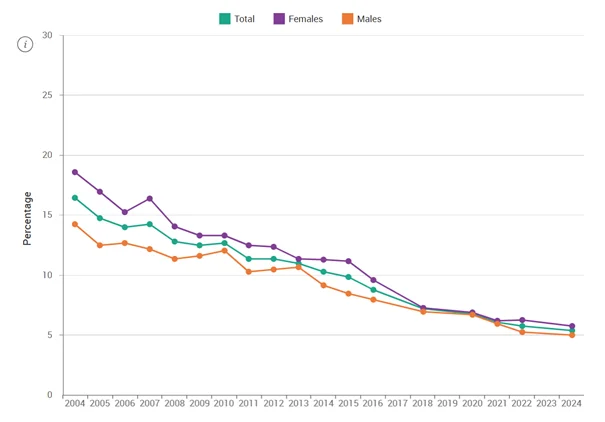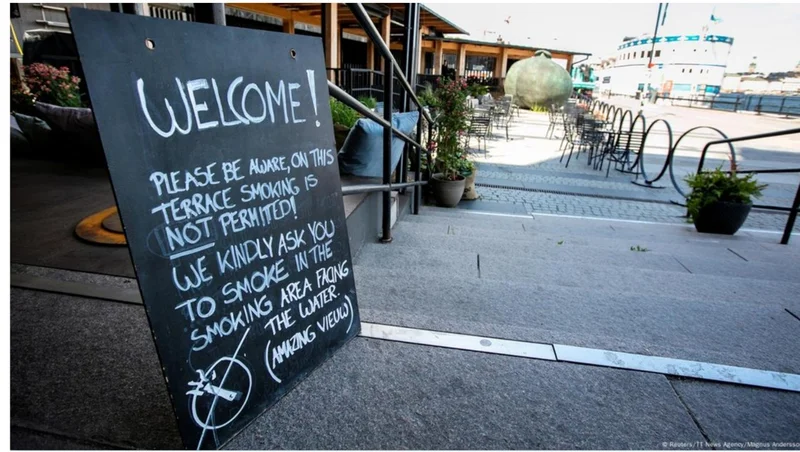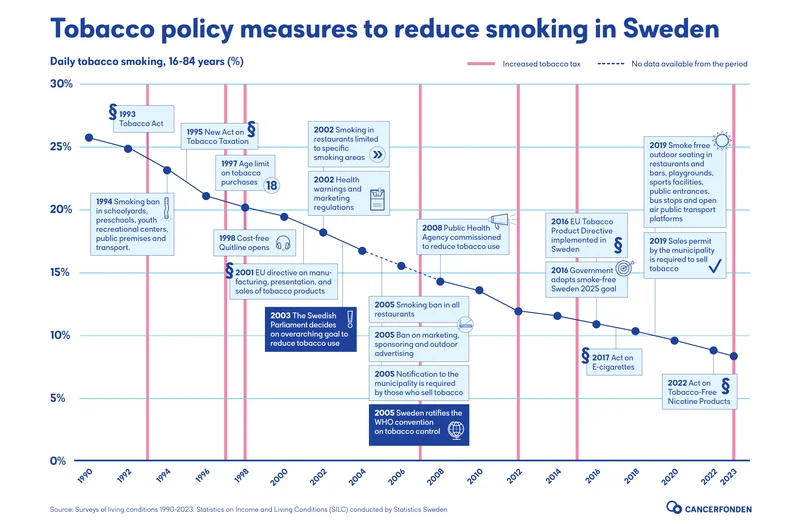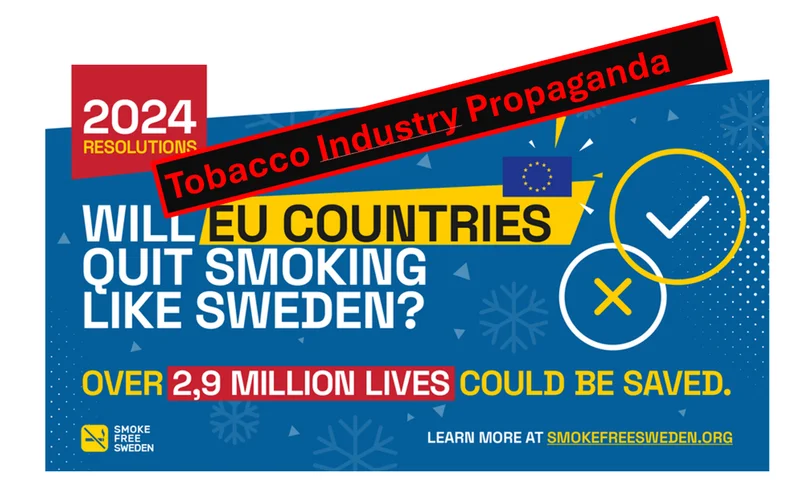- 21.07.2025
- News
- Blog
How Sweden Became a Smoke-Free Success Story
Sweden is on the verge of becoming the first European country to be considered “smoke-free” – with only 5.4% daily smokers. However, while smoking is on the decline, tobacco and nicotine use remains present.
from Angeliki Balantani and Małgorzata Posoch-Gueneau de Mussy
Introduction
Sweden is on track to become the first country in Europe to achieve "smoke-free" status, with daily smoking rates 5,4%[i]. However, when occasional smokers are included, the rate rises to around 11%. Notably, these figures do not account for the use of smokeless alternatives such as snus, meaning that while Sweden may be close to eliminating smoking, it is far from free of tobacco or nicotine use.
Even when occasional smokers are considered, Sweden’s smoking rate remains significantly lower than that of many other countries. What factors, then, have contributed to this remarkable decline?
The role of government policies and regulations
Sweden’s "success story” is strongly linked to a series of government measures implemented over the past 60 years. A key part of the strategy has been to reduce the availability of tobacco products. Sweden has implemented various regulations to this end, such as restricting tobacco sales to licensed vendors and prohibiting sales in places like convenience stores and kiosks. For example, the sale of tobacco is only permitted in stores that have registered with the municipal authorities, and retailers are required to comply with strict rules regarding age verification and display limitations. According to the Swedish Public Health Agency (Folkhälsomyndigheten)[i], these regulations aim to make tobacco products less accessible, especially to minors.
In parallel, the government enforced strict advertising bans and mandated prominent health warnings on tobacco packaging. The Act on Tobacco and Similar Products (SFS 2018:2088[ii]) prohibits tobacco advertising across various media platforms, including publications, television, radio, and other marketing channels. This broad prohibition encompasses domestic print media such as pamphlets, leaflets, flyers, posters, and signs[iii]. Additionally, the Act requires that health warnings cover a significant portion of tobacco packaging, featuring graphic images, text about the health risks of smoking, and information on how to access cessation support[iv]. The goal of these measures is to discourage tobacco use by making the dangers of smoking highly visible to consumers.
These legislative and regulatory efforts have not only reduced access to tobacco but also contributed to a broader cultural shift in attitudes toward smoking in Sweden. Over time, the demand for cigarettes has declined significantly, and smoking has become less socially acceptable. This transformation is reflected in the latest, long-term national data, which shows a decline in daily smoking rates since 2004 (Figure 1[v]). According to data from Public Health Agency of Sweden[vi], both genders have shown a steady decrease in daily smoking prevalence.

Figure 1: Proportion of individuals aged 16–84 who smoke daily during the period 2004–2024, divided by gender. Source: National Public Health Survey, Public Health Agency of Sweden
Finally, Sweden has enforced additional measures to further reduce smoking rates, such as smoking bans in public spaces and increased tobacco taxes. Since 2005, smoking has been prohibited inside all bars and restaurants[vii]. Since 2019 Sweden has been the only European country with a smoking ban in all outdoor dining areas[viii]. Furthermore, it has raised tobacco taxes, including both specific and ad valorem taxes[ix], making tobacco products less affordable, particularly for youth and low-income individuals.

Reuters/TT News Agency/Magnus Andersson
Figure 2: A sign outside a bar in Stockholm requests its customers to smoke elsewhere. Image: Reuters/TT NEws Agency/Magnus Andersson
These measures have proven highly effective in reducing consumption and have played a pivotal role in reshaping public perceptions. Along with strong tax and control policies as well as public health initiatives, Sweden has become one of the countries with the lowest smoking rates in Europe.
Smoking Cessation Services and Resources in Sweden
In addition to the aforementioned strategies, Sweden has implemented a comprehensive approach to support individuals aiming to quit smoking, encompassing increased access to smoking cessation programs, free counselling services, and the provision of nicotine replacement therapies (NRT)[x]. These programs are often integrated into primary healthcare services, ensuring accessibility for the general population[xi]. They typically include counselling sessions, personalized support, behavioural therapy, and guidance on the use of pharmacological aids [xii],[xiii].
An essential aspect of Sweden's tobacco cessation strategy is the provision of free counselling services, such as the Swedish National Tobacco Quitline (Sluta-Röka-Linjen[xiv]). The Quitline provides free, anonymous support via telephone, and advice on NRT such as patches and nicotine gum. Together, these initiatives aim to reduce smoking prevalence and enhance public health.
Key milestones in Sweden’s Decline in Smoking
- 1977 Act on warning labels and content declarations on tobacco products is introduced.
- 1979 Act on the marketing of tobacco and alcohol is introduced.
- 1995 Act on tobacco taxation comes into effect.
- 2002 Health warnings and marketing regulations are introduced in the Tobacco Act.
- 2005 Indoor smoking bans in service establishments are introduced in the Tobacco Act.
- 2005 The WHO Framework Convention on Tobacco Control is ratified.
- 2005 Marketing bans, sponsorship, and outdoor advertising are introduced in the Tobacco Act.
- 2015 The goal of a smoke-free Sweden by 2025 is adopted.
- 2019 The Act on tobacco and similar products is adopted, which includes additional smoke-free outdoor environments and a licensing requirement for selling tobacco.
- 2022 – Enactment of the Act on Tobacco-Free Nicotine Products, regulating products such as nicotine pouches. This law introduced age limits (18 years for sales, 25 years for marketing), delegated oversight to the Swedish Food Agency, and implemented restrictions on marketing and sales.
This remarkable smoking decline that Sweden achieved is the result of decades of gradual implementation of public health policies starting already in the mid ‘60s. Sweden has consistently strengthened its tobacco control laws since 1977 with a legislation mandating warning labels on tobacco products. From increasing taxes in the 1990s to implementing indoor smoking bans and embracing WHO's Framework Convention on Tobacco Control in 2005, each step has built upon the last. The country's adoption of a smoke-free goal by 2025, along with stricter regulations in 2017/18 on licensing requirements to sell tobacco and additional smoke free outdoor environments, reflects a persistent effort to reduce smoking rates and protect public health[xv]. These milestones show how consistent, long-term policy can shift attitudes towards smoking and set an international example.
For a visual timeline that highlights Sweden’s key anti-smoking milestones see the graph from Cancerfonden[xvi], showing how each policy helped pave the way to Sweden’s low smoking rates.

Cancerfonden
Figure 3: Policy measures to reduce tobacco smoking in Sweden 1990–2022
Source: Cancerfonden
Switzerland: a very different situation
In Switzerland, the smoking prevalence is 24% among the population aged 15 and over, making it one of the highest rates in Europe[xvii]. Despite some recent efforts, Switzerland remains on the road toward adopting stricter tobacco control policies. Although Switzerland's Federal Act on Tobacco Products and Electronic Cigarettes (Tobacco Products Act, TobPA) came into force in 2024, it contains significant gaps — such as insufficient restrictions on tobacco advertising and limited protections against secondhand smoke exposure[xviii] — and fails to fully safeguard the population, particularly minors, from the harmful effects of tobacco use. As a result, tobacco consumption remains high, and youth initiation rates show little sign of decline. Switzerland signed the WHO Framework Convention on Tobacco Control (FCTC) in 2004 but has yet to ratify it, leaving international commitments unmet. Furthermore, the ‘Yes to Protecting Children and Young People from Tobacco Advertising’ initiative, launched by major Swiss health organizations, has been waiting to come into force for two years, reflecting persistent delays in implementing stronger measures. To truly address the tobacco epidemic, Switzerland must prioritize the ratification of the FCTC and close the existing legal loopholes to protect public health effectively.
The Tobacco Industry’s Misleading Propaganda
The tobacco industry continues to promote misleading claims by attributing Sweden’s low smoking rates to the legal status of snus, presenting it as a key tool for smoking cessation[xix],[xx].
The tobacco industry is concealed behind several communication initiatives that attempt to promote the false idea that Sweden’s public health results were achieved thanks to the use of snus. One example, among many, of such manipulation is Smoke Free Sweden[xxi]. On its slick website — decorated with the blue and yellow colors of the Swedish flag—this organization spreads half-truths and propaganda to persuade the public that snus was the key to Sweden’s success in tobacco control.
Behind this initiative, once again, is a familiar figure in the tobacco industry's propaganda efforts: Delon Human, associated with the deceptive organization Health Diplomats[xxii]. Human was also involved in the manipulation pretending that electronic cigarettes are 95% less dangerous than traditional cigarettes[xxiii]. Another recent communication initiative promoting industry narratives is “Quit Like Sweden”[xxiv], which has likely been financed by the tobacco industry, although this is not transparently disclosed.

Smoke free Sweden
Figure 4: a propaganda image used by Smoke free Sweden on Twitter/X
The Swedish Cancer Society (Cancerfonden) is very clear in its message: there is no evidence linking the decline in smoking rates to snus use.
While smoking prevalence in Sweden has steadily decreased, the rate of snus use has remained relatively stable over time, suggesting no causal relationship[xxv].
At the European level, the sale of oral tobacco (such as snus) has been widely banned since 1992[xxvi]. In the years that followed, the tobacco industry intensified its efforts to oppose the ban, using "The Swedish Experience" as a strategic argument to advocate for lifting restrictions[xxvii]. This narrative, however, overlooks the broader tobacco control policies that have contributed to Sweden’s success in reducing smoking rates. The fact that snus is legal in Sweden while it has long been banned in other countries is by no means a valid argument to claim that snus is behind Sweden’s tobacco control success. Such a claim is a deliberate distortion — it brushes aside decades of robust public health policies, strong societal support for anti-smoking measures, and strict tobacco regulation. To credit snus alone is not just misleading; it’s propaganda serving industry interests.
Conclusion
Sweden’s journey toward becoming a smoke-free success story serves as a powerful example of how comprehensive public health policies can significantly reduce smoking rates. Through a combination of strict regulations on tobacco sales, advertising, and smoking in public spaces, alongside robust smoking cessation programs, Sweden has managed to reduce its smoking prevalence to one of the lowest in Europe. However, challenges remain, particularly in relation to the rising use of snus, which may present new health risks that need addressing. Despite these challenges, Sweden’s approach offers valuable lessons for other countries striving to tackle tobacco use and improve public health. By implementing a multi-faceted strategy that includes education, regulation, and support for cessation, other nations can follow Sweden's lead in reducing smoking-related diseases and enhancing the well-being of their populations.
Further materials on this topic from Cancerfonden:
[I] Public Health Agency of Sweden, Use of tobacco and nicotine products 2024, . Accessed May 6, 2025https://www.folkhalsomyndigheten.se/the-public-health-agency-of-sweden/living-conditions-and-lifestyle/andtg/tobacco/use-of-tobacco-and-nicotine-products/
[II] Trade in Tobacco Products, Public Health Agency of Sweden, https://www.folkhalsomyndigheten.se/the-public-health-agency-of-sweden/living-conditions-and-lifestyle/andtg/legal-requirements/tobacco-products/trade-in-tobacco-products/. Accessed May 9, 2025
[III] Act (2018:2088) on Tobacco and Similar Products, Tobakslag (2018:2088). Sveriges Riksdag. https://www.riksdagen.se/sv/dokument-och-lagar/dokument/svensk-forfattningssamling/lag-20182088-om-tobak-och-liknande-produkter_sfs-2018-2088/. Accessed May 9, 2025
[IV] Tobacco Control Laws, Campaign for Tobacco-Free Kids, https://www.tobaccocontrollaws.org/legislation/sweden/advertising-promotion-sponsorship/regulated-forms-of-advertising-promotion-and-sponsorships. Accessed May 9, 2025
[V] Tobacco Control Laws, Health Warnings/Messages Features, Campaign for Tobacco-Free Kids https://www.tobaccocontrollaws.org/legislation/sweden/packaging-labeling/health-warnings-messages-features. Accessed May 9, 2025
[VI] Proportion of Individuals aged 16-84 who smoke daily 2004-2024, Public Health Agency of Sweden, https://www.folkhalsomyndigheten.se/the-public-health-agency-of-sweden/living-conditions-and-lifestyle/andtg/tobacco/use-of-tobacco-and-nicotine-products/. Accessed May 9, 2025
[VII] Public Health Agency of Sweden. National Public Health Survey, Use of tobacco and nicotine products. https://www.folkhalsomyndigheten.se/the-public-health-agency-of-sweden/living-conditions-and-lifestyle/andtg/tobacco/use-of-tobacco-and-nicotine-products/. https://www.folkhalsomyndigheten.se/faktablad/datavisualisering/. Accessed May 9, 2025
[VIII] Public Health Agency of Sweden. The smoke-free environments regulated by the Tobacco and Similar Products Act https://www.folkhalsomyndigheten.se/livsvillkor-levnadsvanor/andts/tillsynsvagledning/tobak-och-liknande-produkter/rokfria-miljoer/rokfria-miljoer-med-stod-i-lagen/#Hotell. Accessed May 9, 2025
[IX] Hofverberg, E. (2019) Sweden: New Rules on Smoking in Public Places and Sale of Tobacco Enter into Force. [Web Page] Retrieved from the Library of Congress, https://www.loc.gov/item/global-legal-monitor/2019-09-25/sweden-new-rules-on-smoking-in-public-places-and-sale-of-tobacco-enter-into-force/.
[X] HTP Tax Gap Map: Sweden | Campaign for Tobacco-Free Kids, https://www.tobaccofreekids.org/what-we-do/global/taxation-price/. Accessed May 9, 2025
[XI] Mihretab Gebreslassie, Maria Rosaria Galanti, Inna Feldman, Anton Lager, Should Nicotine Replacement Therapy be Provided Free of Charge? A Cost-Utility Analysis in Sweden, Nicotine & Tobacco Research, Volume 25, Issue 11, November 2023, Pages 1762–1769, https://doi.org/10.1093/ntr/ntad103, Correction to: Should nicotine replacement therapy be provided free of charge?, Nicotine & Tobacco Research, Volume 26, Issue 2, February 2024, Page 253, https://doi.org/10.1093/ntr/ntad164
[XII] Dannapfel, P., Bendtsen, P., Bendtsen, M., & Thomas, K. (2023). Implementing smoking cessation in routine primary care-a qualitative study. Frontiers in health services, 3, 1201447. https://doi.org/10.3389/frhs.2023.1201447
[XIII] Leppänen A, Ekblad S, Tomson T. Experiences of tobacco cessation including a prescription approach among patients in Swedish primary health care with a focus on socioeconomically disadvantaged areas. PLoS One. 2020;15(10):e0240411. Published 2020 Oct 12. doi:10.1371/journal.pone.0240411
[XIV] Leppänen, A., Biermann, O., Sundberg, C.J. et al. Perceived feasibility of a primary care intervention for Tobacco Cessation on Prescription targeting disadvantaged groups in Sweden: a qualitative study. BMC Res Notes 9, 151 (2016). https://doi.org/10.1186/s13104-016-1949-y
[XV] Swedish Quitline. Sluta-röka-linjen för dig som vill sluta med tobak. https://www.slutarokalinjen.se/om-oss/. Accessed May 9, 2025
[XVI] Public Health Agency of Sweden. Towards a smoke-free Sweden. https://www.folkhalsomyndigheten.se/the-public-health-agency-of-sweden/living-conditions-and-lifestyle/andtg/tobacco/towards-a-smoke-free-sweden/. Accessed May 9, 2025
[XVII] Swedish Tobacco Policy, Sweden’s road to reduced tobacco smoking, Cancerfonden, https://www.cancerfonden.se/om-oss/about-us/swedens-road-to-reduced-tobacco-smoking. Accessed May 9, 2025
[XVIII] Swiss Health Survey, The Swiss Confederation, Swiss Health Survey: Tobacco consumption 1992‒2022 - The percentage of smokers has fallen, https://www.news.admin.ch/en/nsb?id=101694. Accessed May 9, 2025
[XIX] Why did Swiss citizens refuse a comprehensive second-hand smoke ban?, Swiss Med Wkly. 2014;144:w13983, https://doi.org/10.4414/smw.2014.13983. Accessed May 12,2025
[XX] Gerhard Gmel, Carole Clair, Ansgar Rougemont-Bücking, Véronique S Grazioli, Jean-Bernard Daeppen, Meichun Mohler-Kuo, Joseph Studer, Snus and Snuff Use in Switzerland Among Young Men: Are There Beneficial Effects on Smoking?, Nicotine & Tobacco Research, Volume 20, Issue 11, November 2018, Pages 1301–1309, https://doi.org/10.1093/ntr/ntx224
[XXI] SBU. Associations between snus, e-cigarettes and tobacco smoking: a systematic review. Stockholm: Swedish Agency for Medical and Social Evaluation (SBU); 2020. SBU prepares 312. [Accessed May 12, 2025]. Available from: https://www.sbu.se/312
[XXII] https://smokefreesweden.org/ - ATTENTION: A WEBSITE SPONSORED BY TOBACCO INDUSTRY
[XXIII] Delon Human, Tobacco Tactics, https://www.tobaccotactics.org/article/delon-human/ updated 20 November 2024, accessed 10 May 2025.
[XXIV] E-cigarettes 95% less dangerous? Myth, scientific lies, and manipulations, Swiss Association for Tobacco Control, https://www.at-schweiz.ch/en/at-blog/95/. Accessed May 12, 2025
[XXV] https://quitlikesweden.org/, ATTENTION: A WEBSITE FINANCED BY TOBACCO INDUSTRY
[XXVI] Swedish Tobacco Policy, Snus use, Sweden’s road to reduced tobacco smoking | Cancerfonden, www.cancerfonden.se/om-oss/about-us/swedens-road-to-reduced-tobacco-smoking. Accessed May 12, 2025
[XXVII] Snus: EU Ban on Snus Sales, Tobacco Tactics, https://www.tobaccotactics.org/article/snus-eu-ban-on-snus-sales/, updated 09 June 2021, accessed 12 May 2025.
[XXVIII] The Swedish Experience, Tobacco Tactics, updated 03 October 2024, https://www.tobaccotactics.org/article/the-swedish-experience/ Accessed 12 May 2025.